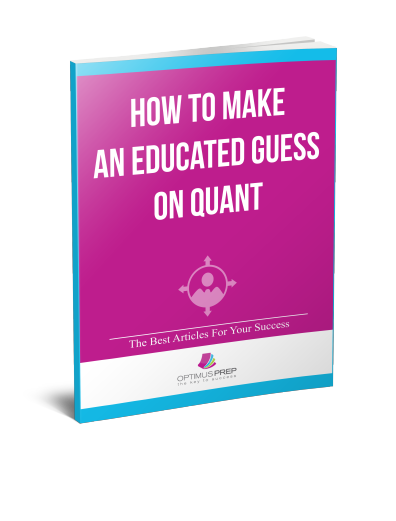
There have been a lot of useful write-ups from students lately. One of the most discussed topic concerns to making educated guesses on the quantitative problems.
What is Educated Guessing?
When referring to random guesses, there are basically two types, you have your random guessing where you haven’t really got a clue what the answer is, you’re just picking. Then you have your educated guesses. With these guesses, you are carefully considering the answers and eliminate the ones that you know are wrong.
Even if we do not know the correct answer right away, we are often able to figure out the correct answers by process of elimination. This strategy is quite effective in narrowing the options down, and better picking the correct answer. However, being able to eliminate the options which are wrong must be learned, they are not a natural skill. The more you practice, like with anything the better you will get at eliminating the incorrect answers.
During a GMAT test, there will inevitably come a time when you will have to guess. There’s no denying that; no-one is intelligent enough to get all the answers correct. So having the ability to make an educated guess can be extremely useful.
When should you make an Educated Guess?
On the Quant section, an average of 2 minutes is allowed for each question. Half-way through the section, we have a pretty good idea of how to solve this question and have a general idea regarding how to calculate the solutions. So, if you are lagging behind by the one minute mark, it is a good time to start making educated guesses.
Useful techniques
The type of techniques vary according to the type of questions. Some of the techniques are applicable to large types of questions, while others will only work on a selected group of questions. One of the best ways of learning elimination techniques is to apply it to the questions you know the answers to. In this way, you will have a better understanding of the technique and how you can apply it to difficult questions.
On problem solving questions, it is advisable to have a look at the answers before getting on to the solution. Answers can provide useful hints regarding how you should approach the problem.
Estimation
Look for the keywords similar to ‘approximately’ in the problem. Look for a diagram or the possibility of drawing one yourself. This will help you make an estimated guess regarding the answer. Also, look closely to be sure you understand the question in terms of ‘more than half or less than half’. Problems relating to probability, work, fraction, sets and presents can be solved by looking at them in terms of ‘positive vs. negative’ or ‘greater than vs. less than’. This will help you eliminate a few answers.
Study the answer
If your answers are small numbers that can be used easily, you should consider trying them in the problems. This may allow you to figure out if you need a larger or smaller number. If you find out that you need a larger number, you can eliminate the smaller numbers.
Picking the number
Try picking an easy number by finding an answer which fits in the questions. For example, ones that have variable expressions in the answer. It can significantly lower your number of choices.
Knowing the Data Sufficiency answer
It sounds difficult, but is incredibly easy. If the two given statements say precisely the same thing, then the answer is either D or E (try to figure out why). If the second statement has some additional information and says precisely the same thing as the first statement, the answer is neither A nor C. In the case that the first statement has the additional information, then the answer is neither B nor C. If the two statements together will work and it is evident, then the answer is most likely A or B. If one statement stands out and it is complicated, and filled with jargons, bet on it.
The classic odd man out (Problem Solving)
If the answers to the problems are presented in pairs, then it is easy to eliminate the wrong answer. Consider a problem based on the total distance traveled by two people, John and Mark. Now the answers that do not add up to the total distance are obviously wrong. Also, from the additional details you can figure out whether John walked more or less than half the total distance. You can narrow down the answers significantly this way.

